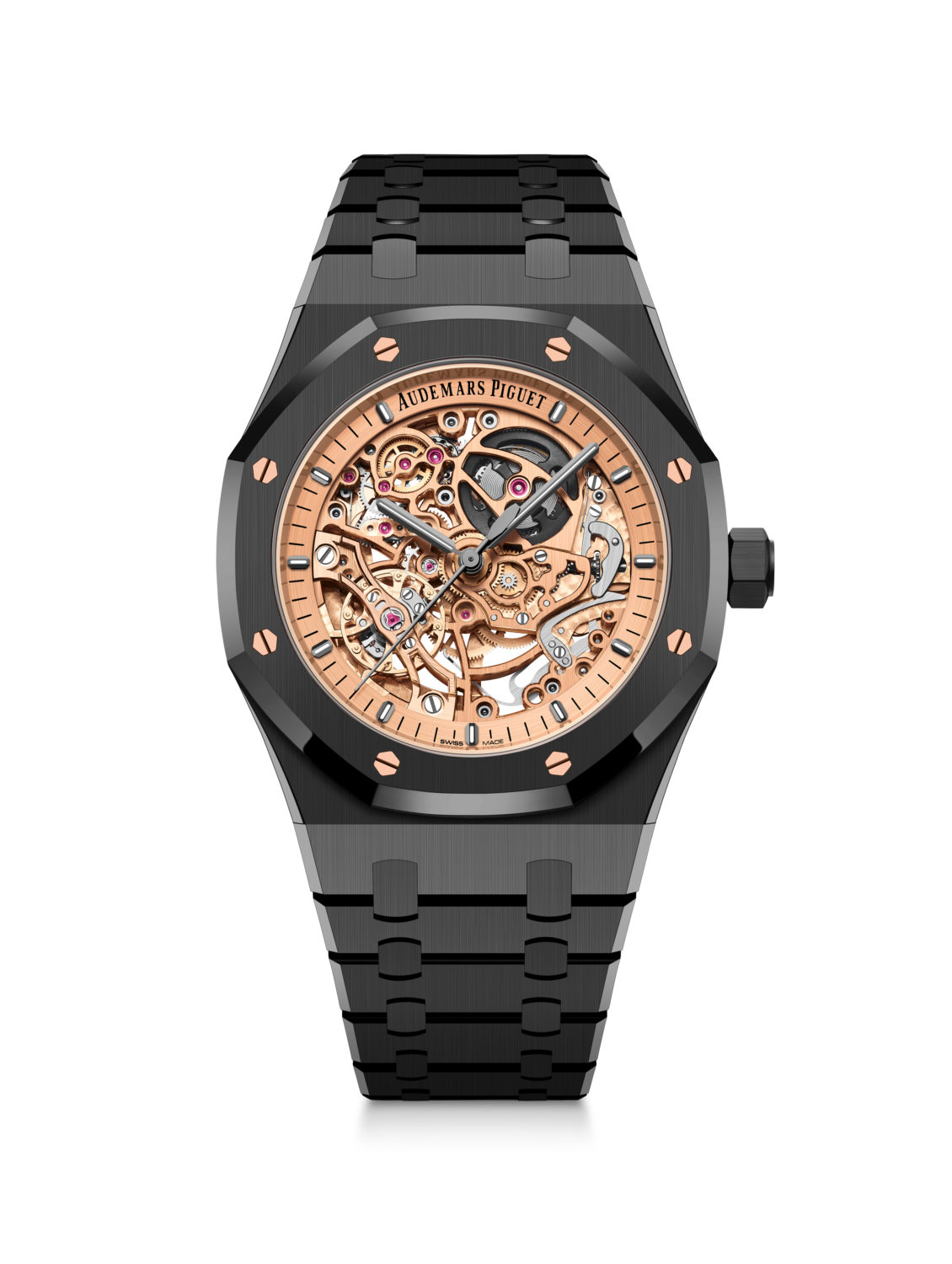
Swiss Haute Horlogerie manufacturer Audemars Piguet is happy to reveal three new references of the Royal Oak Double Balance Wheel Openworked in 41 mm offering a diversity of materials and aesthetics. Executed in either stainless steel, black ceramic or 18-carat yellow gold, these three models give centre stage to the selfwinding Calibre 3132, whose openworked architecture emphasises the dexterity of Audemars Piguet’s artisans. Two of these timepieces introduce the detailedmovement in a new pink-gold tone, for a rich play of light. Combining technical precision with age-old skills, these new iterations will adorn the wrists with elegance and finesse.
- The three new Royal Oak Double Balance Wheel Openworked models in 41 mm are available in stainless steel, black ceramic and yellow gold for rich contrasted aesthetics. © Courtesy of Audemars Piguet.

THREE CONTRASTED AESTHETICS
The Royal Oak Double Balance Wheel Openworked line evolves with three new 41 mm models crafted in different materials. Executed in either stainless steel, black ceramic or 18-carat yellow gold, the case and bracelet are decorated with the collection’s distinctive finishing techniques alternating polished and satin-brushed surfaces that play on the light and underline the Royal Oak’s geometrical design.
The openworked movement and inner bezel of the steel and black ceramic variations feature a new pink-gold tone bringing a warm and vivid touch to the watch, while underlining the precision-work of its different components. The eight hexagonal screws on the bezelare also crafted in pink gold and harmoniously echo thehue of the movement. Furthering the visual contrast, the 18-carat white gold hour-markers and hands offer clear readability on the stainless-steel version, while those on the ceramic model are applied in blackened rhodium. Finally, the seconds indication and the “Audemars Piguet” signature are printed in black on the inner bezel. Moreover, the black ceramic reference is engraved with “Limited Edition of 150 Pieces” on its titanium and sapphire caseback.

Alternatively, the 18-carat yellow gold reference displays a bold aesthetic blending the bright precious material with an anthracite grey openworked movement, enhanced by a matching inner bezel with the seconds scale and “Audemars Piguet” logo printed in white. The yellow gold applied hour-markers and hands with luminescent material emphasise the two-tone design, while ensuring optimum visibility even in the dark.
A PATENTED MECHANISM
These new models are powered by the Calibre 3132, a selfwinding movement equipped with a double balance wheel mechanism. This patented innovation, released by Audemars Piguet in 2016, provides the watch with enhanced precision and stability. By incorporating two balance wheels and two hairsprings assembled on the same axis, the system oscillates in perfect synchrony. Visible on both sides of the case, the double balance wheel confers a rare glimpse of the watch’s beating heart. The openworked bridges on either side of the watch reveal some components of the gear train. Their geometries were cut using advanced production technologies, such as computer numerical control (CNC) machining, before being refined into the desired shape. Each component was then finished and decorated using age-old techniques. The polished V-angles reflect the meticulous craftsmanship that went into their creation, as this level of precision can only be achieved by hand.

The openworked oscillating weight, matching the colour of the case for the steel and yellow gold models or harmonised with the pink gold movement for the black ceramic version, completes the contrasted aesthetic of these three references.
THE DELICATE ART OF OPENWORKING
Combining aesthetics and function, openworking has been an Audemars Piguet specialty since the 1930s. This art consists of removing as much material as possible from the mainplate and bridges to let the light through, revealing the beauty and finesse of the mechanism without compromising functionality. It therefore requires true watchmaking mastery and an in-depth knowledge of materials and finishing techniques.

In the early 1970s, a handful of young Audemars Piguet watchmakers, encouraged by their elders, decided to rediscover the art of openworking, which had fallen into disuse after the 1950s, and set up the brand’s first workshop dedicated to this technique. The visionary Georges Golay, then Director of Audemars Piguet, set the artisans an ambitious challenge: to create 100 openworked examples of the Calibre 2120, a meticulous task requiring 150 hours of work for each movement. The first watch (Model 5442) was delivered in November 1973, followed by thirty more between then and 1976. In 1978, the Manufacture produced 300 openworked timepieces powered by Calibre 2120. By 1984, the workshop employed a dozen craftspeople.
In the early years of the Royal Oak collection, the calibres remained hidden inside the cases. It was the advent of quartz that redefined the watchmaking codes, prompting the industry to showcase the beauty of mechanical movements and the traditional skills required to create them. Openworking first appeared in 1981 in the form of a pendant for the Royal Oak collection (Model 5710BA), followed in 1986 by the Model 25636, which was equipped with Calibre 2120/2800, an ultra-thin perpetual calendar movement. However, it was in the 1990s, a decade characterised by an abundance of Royal Oak models of all shapes and sizes, that this refined art found its true place in the collection, making its debut in the “Jumbo” line in 1992.

Over the decades, the Royal Oak collection has grown to include some fifty openworked references, each powered by different movements and available in a variety of sizes, materials and styles, all reflecting years of passion and expertise handed down from generation to generation. Today, these 41 mm novelties breathe new life into this meticulous art, combining it with a distinctly contemporary aesthetic.







